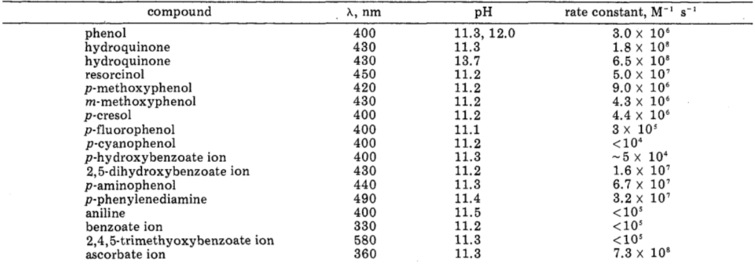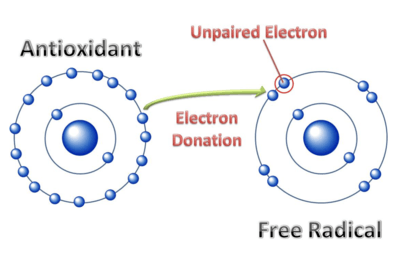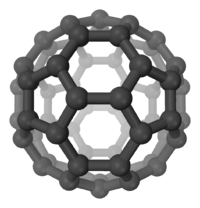Amino radical
The amino radical, •
NH
2, also known as the aminyl radical or azanyl radical, is the neutral form of the azanide ion (NH−
2). Aminyl are highly reactive and consequently short lived like most radicals; however, they form an important part of nitrogen chemistry. In sufficiently high concentration, amino radicals dimerise to form hydrazine. While NH2 as a functional group is common in nature, forming a part of many compounds (e.g. the phenethylamines), the radical cannot be isolated in its free form.[2]
| |||
| Names | |||
|---|---|---|---|
| Systematic IUPAC name | |||
| Other names
Amidogen; Aminyl radical; Azanyl radical | |||
| Identifiers | |||
3D model (JSmol) |
|||
| ChEBI | |||
| ChemSpider | |||
PubChem CID |
|||
| |||
| |||
| Properties | |||
| NH 2• | |||
| Molar mass | 16.0226 g mol−1 | ||
| Thermochemistry | |||
Std molar entropy (S |
194.71 J K−1 mol−1 | ||
Std enthalpy of formation (ΔfH⦵298) |
190.37 kJ mol−1 | ||
Except where otherwise noted, data are given for materials in their standard state (at 25 °C [77 °F], 100 kPa). | |||
| Infobox references | |||
History and background
Historically, it is generally accepted that the first free radical was identified by Moses Gomberg in 1900; this radical was triphenylmethyl radical.[3] While in general the use of free radicals in organic transformations is difficult to control, organic syntheses with free radicals began in 1937 with Heyes and Waters.[4] After 1940, deeper insights into the formation, structure and reactions of free radicals showed how to control these reactive species in chemical reactions. However, in the 1970s, Lamb[5] and Julia[6] witnessed the beginning of new synthetic methodologies involving free radicals. Nowadays, free radicals are widely used in synthetic reactions.
Electronic states of amino radical
The amino radical has two characteristic electronic states:

The more stable electronic state is 2B1 states, where the unpaired electron is in the p-orbital perpendicular to the plane of the molecule (π type radical). The high energy electronic state, 2A1, has the two electrons in the p-orbital and the unpaired electron in the sp2 orbital (σ type orbital).[7][8]
Nitrogen centered compounds, such as amines, are nucleophilic in nature, hence, this character is also seen in amino radicals and can be considered to be nucleophilic species.[7][8]
Spectral properties
The amino radical only exhibits a very low optical absorption in the visible region (λmax 530 nm, εmax 81 M−1 s−1), while its absorption in the UV (<260 nm) is similar to that of OH. Due to this, it is impractical to determine the rate of reaction of the amino radical with organic compounds by following the decay of the amino radical .
Synthesis
Reaction 1: Formation of amino radical from ammonia
Amino radicals can be produced by reacting OH radical with ammonia in irradiated aqueous solutions. This reaction is formulated as a hydrogen abstraction reaction.[9]
- NH3 + •OH → •NH2 + H2O
The rate constant (k1) for this reaction was determined to be 1.0 × 108 M−1 s−1, while the parallel reaction of OH with NH+
4 was found to be much slower. This rate was re-determined by using two pulse radiolysis competition methods with benzoate and thiocyanate ions at pH 11.4. A value of k1 = (9 + 1) × 107 M−1 s−1 was obtained from both systems. While in acidic solution, the corresponding reaction of •OH with NH+
4 is too slow to be observed by pulse radiolysis.
Reaction 2: Formation of amino radical from hydroxylamine
The amino radical may also be produced by reaction of e−(aq) with NH2OH. Several studies also utilized the redox system of TiIII—NH2OH for the production of amino radicals using electron paramagnetic resonance (ESR) spectroscopy and polarography.[9]
- TiIII + NH2OH → TiIV + •NH2 + OH−
Reaction 3: Formation of amino radical from ammoniumyl
Reduction of hydroxylamine by e−(aq) has also been suggested to produce the amino radical in the following reaction.[9]
- •NH+
3 ⇌ •NH2 + H+
The reactivity of the amino radical in this reaction is expected to be pH dependent and should occur in the region of pH 3–7.
Reactivity
In general, amino radicals are highly reactive and short lived; however, this is not the case when reacted with some organic molecules. Relative reactivities of the amino radical with several organic compounds have been reported, but the absolute rate constants for such reactions remain unknown. In reaction 1, it was hypothesized that the amino radical might possibly react with NH3 more rapidly than OH and might oxidize NH+
4 to produce the amino radical in acid solutions, given that radicals are stronger oxidants than OH. In order to test this, sulfate and phosphate radical anions were used. The sulfate and phosphate radical anions were found to react more slowly with NH3 than does the amino radical and they react with ammonia by hydrogen abstraction and not by electron transfer oxidation.[9]
When the amino radical is reacted with benzoate ions, the rate constant is very low and only a weak absorption in the UV spectra is observed, indicating that amino radicals do not react with benzene rapidly. Phenol, on the other hand, was found to react more rapidly with the amino radical. In experiments at pH 11.3 and 12, using 1.5 M NH3 and varying concentrations of phenol between 4 and 10 mM, the formation of the phenoxyl radical absorption was observed with a rate constant of (3 + 0.4) × 106 M−1 s−1. This reaction can produce phenoxyl radicals via two possible mechanisms:[9]
- Addition to the ring followed by elimination of NH3, or
- Oxidation by direct electron transfer

While the amino radical is known to be weakly reactive, the recombination process of two amino radicals appears to be one of the fastest. As a result, it often competes with other NH2 reactions and it follows that reaction mechanism involving the amino radical.
- NH2 + NH2 → N2H4
This reaction is the only pathway for NH2 disappearance, and approaches products faster at low pressure.[10]
Applications and Impact on Human Health
Free nitrogen radical species are generated by the human body by various endogenous systems. A balance between free radicals and antioxidants is crucial for proper physiological function. Free radicals can adversely alter lipids, proteins and DNA and trigger a number of diseases. Free radicals are derived either from normal essential metabolic processes in the human body or from external sources, such as exposure to X-rays, cigarette smoking and industrial chemicals. In cells, free radical formation occurs continuously as a consequence of both enzymatic and nonenzymatic reactions.[11] On the other hand, free radicals are very effective in carrying out transformations in highly hindered environments with a high degree of chemoselectivity as they are small and more penetrating than carbanions and carbocations. Therefore, molecules which contain many polar functional groups are tolerated by free radicals.[12]
Nitrogen radicals and carcinogenesis
Reactive nitrogen species, such as the amino radical, play an important role in carcinogenesis. They induce DNA damage, as the reaction of free radicals with DNA includes strand break base modification and DNA protein cross-links. Hence, it is clear that their presence in biosystems could lead to mutation, transformation, and ultimately cancer.[11]
Antioxidants

An antioxidant is a molecule stable enough to donate an electron to a free radical and neutralize it, thus reducing its capacity to damage. Some are produced during normal metabolism in the body, while others are found in diet. These antioxidants delay or inhibit cellular damage mainly through their free radical scavenging property, as they can safely interact with free radicals and terminate the chain reaction before vital molecules are damaged. There are two principal mechanisms of action of antioxidants:
- The first is a chain-breaking mechanism by which the primary antioxidant donates an electron to the free radical present
- The second mechanism involves removal of reactive nitrogen species initiators by quenching chain-initiating catalyst.
In biological systems, antioxidants exert their effect by different mechanisms including electron donation, metal ion chelation, co-antioxidants, or by gene expression regulation.[11]
See also
- Amide
- Amine
- Radical (chemistry)
- Hydrazine (dimer)
References
- "aminyl (CHEBI:29318)". Chemical Entities of Biological Interest (ChEBI). UK: European Bioinformatics Institute. IUPAC Names.
- die.net. "Amidogen". Archived from the original on February 21, 2013. Retrieved May 16, 2012.
- Gomberg, M. (1900). "An Instance of Trivalent Carbon: Triphenylmethl". Journal of the American Chemical Society. 22 (11): 757–771. doi:10.1021/ja02049a006. ISSN 0002-7863.
- Hey, Donald H.; Waters, William A. (1937). "Some Organic Reactions Involving the Occurence [sic] of Free Radicals in Solution". Chemical Reviews. 21 (1): 169–208. doi:10.1021/cr60068a006. ISSN 0009-2665.
- Lamb, Robert C.; Ayers, Paul Wayne; Toney, Myron K. (1963). "Organic Peroxides. II. the Mechanism of the Thermal Decomposition of 6-Heptenoyl Peroxide in Toluene. the Rearrangements of the 5-Hexenyl Radical". Journal of the American Chemical Society. 85 (21): 3483–3486. doi:10.1021/ja00904a039. ISSN 0002-7863.
- Julia, Marc (2002). "Free-radical cyclizations". Accounts of Chemical Research. 4 (11): 386–392. CiteSeerX 10.1.1.628.3293. doi:10.1021/ar50047a005. ISSN 0001-4842.
- "Amino Radical". NIST Chemistry WebBook. National Institute of Science and Technology. 2017. Retrieved 15 June 2018.
- Koenig, T.; Hoobler, J. A.; Klopfenstein, C. E.; Hedden, G.; Sunderman, F.; Russell, B. R. (1974). "Electronic configurations of amido radicals". Journal of the American Chemical Society. 96 (14): 4573–4577. doi:10.1021/ja00821a036. ISSN 0002-7863.
- Neta, P.; Maruthamuthu, P.; Carton, P. M.; Fessenden, R. W. (1978). "Formation and reactivity of the amino radical". The Journal of Physical Chemistry. 82 (17): 1875–1878. doi:10.1021/j100506a004. ISSN 0022-3654.
- Khe, P. V.; Soulignac, J. C.; Lesclaux, R. (1977). "Pressure and temperature dependence of amino radical recombination rate constant". The Journal of Physical Chemistry. 81 (3): 210–214. doi:10.1021/j100518a006.
- Lobo, V; Patil, A; Phatak, A; Chandra, N (2010). "Free radicals, antioxidants and functional foods: Impact on human health". Pharmacognosy Reviews. 4 (8): 118–126. doi:10.4103/0973-7847.70902. PMC 3249911. PMID 22228951.
- Shah, Hitesh (1999). Studies of aminyl radicals (PhD). Loughborough University. hdl:2134/26945.
Further reading
- Davies, P (2008). "Detection of the amino radical NH2 by laser magnetic resonance spectroscopy". The Journal of Chemical Physics. 62 (9): 3739. doi:10.1063/1.430970.
- Buttner, T (2005). "A stable aminyl radical metal complex". Science. 307 (5707): 235–8. Bibcode:2005Sci...307..235B. doi:10.1126/science.1106070. PMID 15653498.
- John, Seely (1977). "Temperature and Pressure Dependence of the Rate Constant for the HO2 + NO Reaction". The Journal of Physical Chemistry. 81 (10): 210–214. doi:10.1021/jp952553f.
- Koenig, Hoobler (1974). "Electronic configurations of amino radicals". Journal of the American Chemical Society. 96 (14): 4573–4577. doi:10.1021/ja00821a036.


